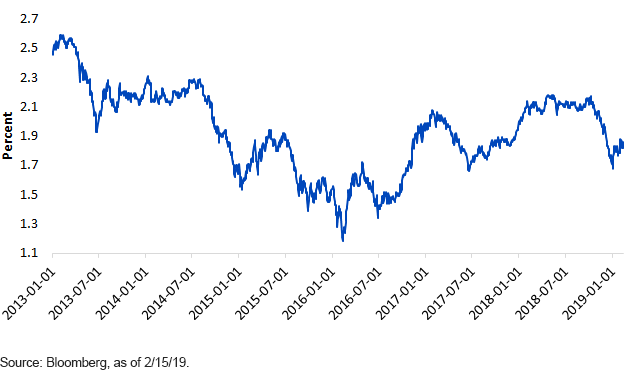Should The Bond Market Expect The Unexpected?
Quick question: What typical bond market catalyst has received scant attention of late? Obviously, it’s not Federal Reserve (Fed) policy, nor is it some of the latest softer-than-expected U.S. economic data, such as retail sales and industrial production. Give up? How about inflation? While the most recent report on the Consumer Price Index (CPI) was not headline-grabbing, I’m going to pose the following question: Should the bond market expect the unexpected?
CPI is the most closely watched inflation measure on a broader basis. Certainly, the overall number will grab the limelight, but the Fed and the fixed income arena gravitate more toward the core rate or CPI excluding food and energy. I know we all have to eat and heat or air condition our homes, not to mention put gasoline into our cars, but food and energy prices can be volatile and affected by other forces that are not really related to the economy, such as weather. Against this backdrop, the preferred gauge to measure underlying demand pressures is core CPI, which will be the topic of this blog post.
10-Year Breakeven Inflation Rate

For the record, the government agency that produces the CPI report, the Bureau of Labor Statistics, was open for business during last month’s shutdown, so the data-gathering process was essentially business as usual. In January, core CPI rose +0.2%, or +2.2% on an annualized basis. Interestingly, both overall CPI and CPI minus the food and energy component hit their recent peaks in July of last year—+2.9% and +2.4%, respectively—but due to a plunge in gasoline prices, the headline figure has seen its year-over-year reading drop to +1.6%, while the core reading has held up reasonably well, coming in at +2.2% the last three months.
What could the future hold? As the accompanying graph highlights, market expectations are not looking for any uptick in inflation pressures. The 10-year breakeven inflation rate measures the difference between the yield on a nominal bond (U.S. Treasury 10-Year note) and an inflation-linked or real yield bond with the same maturity (10-Year Treasury Inflation-Protected Securities, or TIPS). This spread reflects the markets expected inflation rate—a widespread equates to a market expectation of higher inflation, and vice versa. As you can see, expectations sunk into early this year in response to the risk-off trade and have bounced a bit over the last month, but the level is still well below where it resided in early October.
Conclusion
If core CPI manages to continue registering gains in the area of +0.2% on a monthly basis going forward, the year-over-year reading has the potential to move back up toward the aforementioned peak of +2.4%. In fact, over the last three months, the annualized reading has crept up over the +2.5% threshold. While I’m certainly not going to invoke the “inflation boogeyman,” one has to wonder if the bond market has become too complacent on this front.
Disclaimer: Investors should carefully consider the investment objectives, risks, charges and expenses of the Funds before investing. U.S. investors only: To obtain a prospectus containing this ...
more


